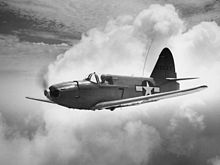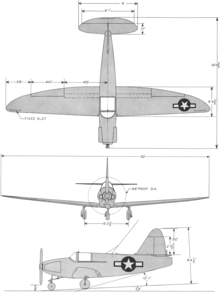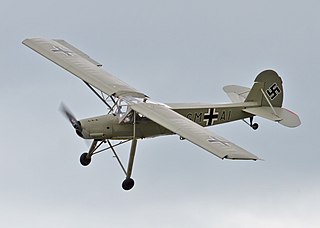
The Fieseler Fi 156 Storch was a German liaison aircraft built by Fieseler before and during World War II. Production continued in other countries into the 1950s for the private market. It was notable for its excellent short field (STOL) performance and low stalling speed of 50 km/h. French-built later variants often appear at air shows. Compared to most other liaison aircraft of the period, the Storch was quite large and heavy, with its wingspan exceeding 14 meters and its weight slightly over 1,300 kg when fully loaded. It was significantly heavier, slower, and less agile than Allied liaison aircraft such as the American Piper L-4 or Stinson L-5, or the British Auster.

The Vultee BT-13 Valiant is an American World War II-era basic trainer aircraft built by Vultee Aircraft for the United States Army Air Corps, and later US Army Air Forces. A subsequent variant of the BT-13 in USAAC/USAAF service was known as the BT-15 Valiant, while an identical version for the US Navy was known as the SNV and was used to train naval aviators for the US Navy and its sister services, the US Marine Corps and US Coast Guard.
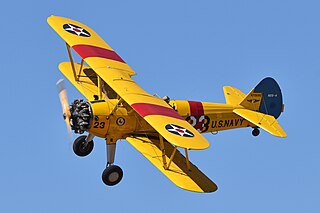
The Stearman (Boeing) Model 75 is a biplane formerly used as a military trainer aircraft, of which at least 10,626 were built in the United States during the 1930s and 1940s. Stearman Aircraft became a subsidiary of Boeing in 1934. Widely known as the Stearman, Boeing Stearman, or Kaydet, it served as a primary trainer for the United States Army Air Forces, the United States Navy, and with the Royal Canadian Air Force as the Kaydet throughout World War II. After the conflict was over, thousands of surplus aircraft were sold on the civilian market. In the immediate postwar years, they became popular as crop dusters and sports planes, and for aerobatic and wing walking use in air shows.

The Beechcraft Model 17 Staggerwing is an American biplane with an atypical negative wing stagger. It first flew in 1932.

The Yankee Air Museum is an aviation museum located at Willow Run Airport in Van Buren Township, Michigan. The museum has a small fleet of flying aircraft and a collection of static display aircraft outdoors.

The Naval Aircraft Factory N3N was an American tandem-seat, open cockpit, primary training biplane aircraft built by the Naval Aircraft Factory (NAF) in Philadelphia, Pennsylvania, during the 1930s and early 1940s.
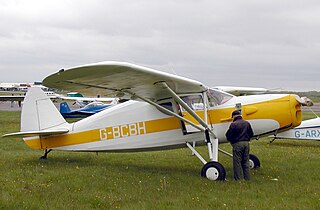
The Fairchild Model 24, also called the Fairchild Model 24 Argus and UC-61 Forwarder, is a four-seat, single-engine monoplane light transport aircraft designed by the Fairchild Aviation Corporation in the 1930s. It was adopted by the United States Army Air Corps as UC-61 and also by the Royal Air Force. The Model 24 was itself a development of previous Fairchild models and became a successful civil and military utility aircraft.

The Beechcraft Model 18 is a 6- to 11-seat, twin-engined, low-wing, tailwheel light aircraft manufactured by the Beech Aircraft Corporation of Wichita, Kansas. Continuously produced from 1937 to November 1969, over 9,000 were built, making it one of the world's most widely used light aircraft. Sold worldwide as a civilian executive, utility, cargo aircraft, and passenger airliner on tailwheels, nosewheels, skis, or floats, it was also used as a military aircraft.
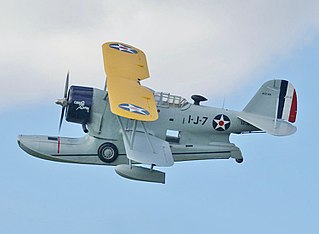
The Grumman J2F Duck is an American single-engine amphibious biplane. It was used by each major branch of the U.S. armed forces from the mid-1930s until just after World War II, primarily for utility and air-sea rescue duties. It was also used by the Argentine Navy, who took delivery of their first example in 1937. After the war, J2F Ducks saw service with independent civilian operators, as well as the armed forces of Colombia and Mexico.

The Ryan PT-22 Recruit, the main military version of the Ryan ST, is a military trainer aircraft that was used by the United States Army Air Corps during WWII for primary pilot training.

The Percival Pembroke is a British high-wing twin-engined light transport aircraft built by the Percival Aircraft Company, later Hunting Percival.
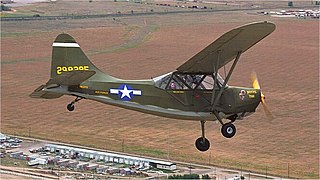
The Stinson L-5 Sentinel is a World War II-era liaison aircraft used by the United States Army Air Forces (USAAF), U.S. Army Ground Forces, U.S. Marine Corps and the British Royal Air Force. It was produced by the Stinson Division of the Vultee Aircraft Company. Along with the Stinson L-1 Vigilant, the L-5 was the only other USAAF liaison aircraft that was exclusively built for military use and had no civilian counterpart.
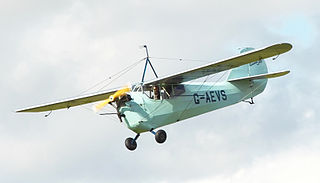
The Aeronca C-3 was a light plane built by the Aeronautical Corporation of America in the United States during the 1930s.

The Culver Cadet is an American two-seat light monoplane aircraft, also as a radio-controlled drone, produced by the Culver Aircraft Company.
The Fletcher FBT-2 was a military trainer aircraft built in the United States in the early 1940s. Although it was never entered production as a trainer, it was ordered in small numbers as a target drone but when that was cancelled played a small part in the development of guided bombs.
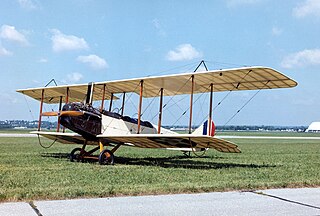
The Standard J is a two-seat basic trainer two-bay biplane produced in the United States from 1916 to 1918, powered by a four-cylinder inline Hall-Scott A-7a engine. It was constructed from wood with wire bracing and fabric covering. The J-1 was built as a stopgap to supplement the Curtiss JN-4 in production.

The Culver Aircraft Company was an American aircraft manufacturer of light aircraft of the 1930s and 1940s.

The Vintage Flying Museum is a non-profit aviation museum located at Meacham International Airport, Fort Worth, Texas. The primary mission of the museum is to preserve America's flying heritage in word, deed and action. Also located at the museum is Greatest Generation Aircraft, the Invader Squadron of the Commemorative Air Force, the Fort Worth Chapter of the American Rosie the Riveter Association and PGM Aviation.

